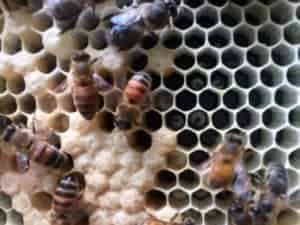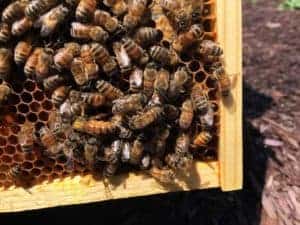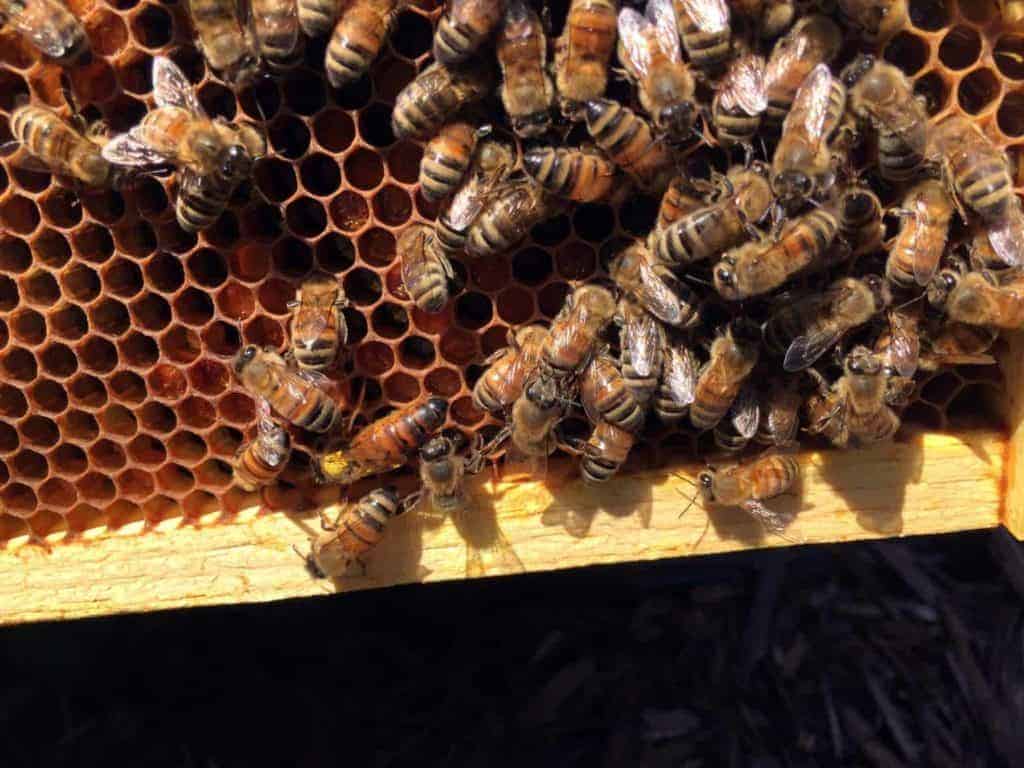Last week, we completed our discussion of Varroa Mite treatment options and I shared my choices for treatment. This week I will be dealing with a few questions that have arisen including dealing with wax moths and some initial discussion of preparing for overwintering your colonies.
But before we tackle those issues, let’s talk about what happened in the bee yard this week. All the colonies but the nucleus hive are showing continuing positive growth patterns.
Hive Updates
This week saw some developments in the bee yard that caused some concern, but the overall news is positive. The three queenright colonies are showing some clear signs of a growth spurt as I prep for treating for Varroa Mites. And I still haven’t quite settled on a name for the apiary.
But, given my love of Tolkien, I can’t help but think of Beorn in The Hobbit. Beorn’s bee pastures factor prominently in The Hobbit. So, tentatively, I am considering “Beorn’s Acres”. A little digression into language is in order . . . Beo is the word for bee in Old English. This just seems to fit with my rather interestingly named hives.
Now for some updates from the hives. This week I want to start with the nucleus hive.
Nucleus Hive – Lack of Growth
Last week, there were two queen cups present in this small colony. One of those cups, if you recall, was slightly open. The bees decided this was not a viable queen. By the next morning, the workers had removed her from the colony and left her on the ground in front of the colony.
That meant I was down to one viable option with a dwindling population. So, I decided to take some corrective action to assists these bees. I noticed that there appeared to be some evidence that the larger colonies were robbing the nucleus colony. So, that represented two problems:
- A quickly dwindling population of workers, and
- Attacks by stronger colonies robbing needed resources.
On Thursday, I decided to take corrective action for the first issue. I opened up Hive Acquitaine and found two frames with nurse bees and eggs, larvae, and uncapped brood. I transferred those two frames to the nucleus colony and replaced them in Hive Acquitaine with the two empty frames from the nucleus colonies.
By Thursday evening, this little colony was acting quite normally with foraging activity resuming and much more activity. That was gratifying to see.
Dastardly Robbers
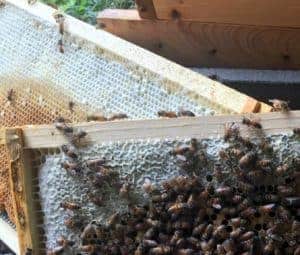
I had planned on moving the colony up to the lower driveway on a pallet Thursday evening. After dark fell, I carried the colony up the hill and filled the entrance with grass to force re-orientation flights. I also made up a new run of sugar water to refill the top hive feeders in Hive Acquitaine and the Nucleus Colony which I did on Friday morning.
But, by Friday mid-day, I noticed a frenzy of activity in front of the nucleus colony. There were too many bees for this colony. I suspected that one of the larger colonies smelled the sugar water and were robbing the colony. I worked the hive and did my best to chase off the marauding invaders. Now, I have researched how to stop robbing behavior.
Closing up the hive is one option as is covering the hive with a wet cloth. I opted for moving the hive one more time and reducing the entrance to a small opening. In fact, that smaller entrance seemed to do the trick.
I also have placed the top hive feeders back on all the colonies and fed them, to keep them from finding the nucleus colony’s feeder too overly attractive. The interesting thing is that the robbing attack seemed to focus on the top hive feeder and not their honey stores. During the attack, the marauders robbed a significant number of honey cells. So, they were smelling the sugar water but took an opportunity to take some honey as well. Ugh!
Inspection
Despite the robbing, the colony came through the process exceptionally well. The workers have already put to good use the two frames of brood transferred from Hive Acquitaine. Two of the young larvae are being fed to become queens. So with one capped cell, which I have doubts will emerge, and now two uncapped cells.
The 16 days cycle to a queen has begun again in this colony. My backup plan is a queen introduction if they fail to raise a queen who makes a successful mating flight. Time will tell. At this point, I really want to see this colony make it to a deep box and form my fourth hive in one season.
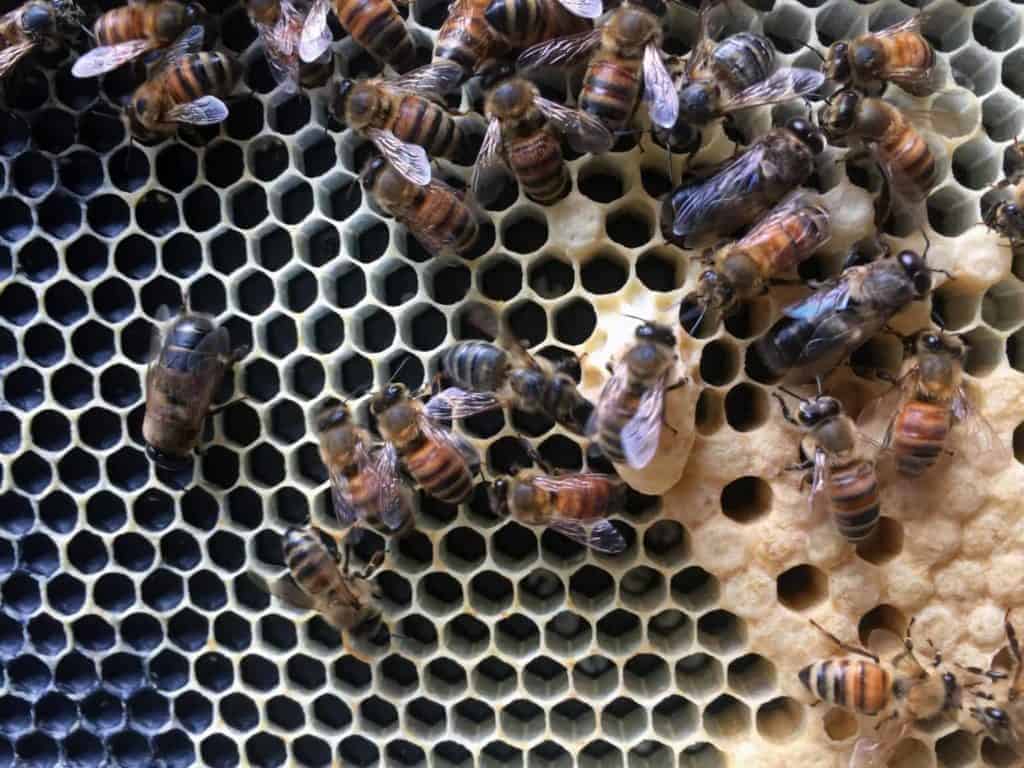
Hive Acquitaine – Growth Pattern Impressive
It appears that there was a robbing attempt on this colony as well. I suspect the sugar water that I fed them encouraged the attacks.
These bees have been busy over the past few weeks. The ten empty frames in the second deep box placed a few weeks ago almost all have drawn comb on at least one side. Eleanor has been a very busy queen laying eggs in almost every available space. There are spaces in the lower deep so hopefully she will move there to continue production.
The brood pattern is equally impressive. A couple of frames are wall-to-wall eggs. In a couple of weeks a totally new generation of workers will emerge.
I will need to continue feeding these bees to assist them in their preparations for winter. They don’t yet have enough honey stores for the winter. But there is plenty of time yet for them to create additional honey stores. I will place the new medium box that I bought for this hive likely next week. I refilled their top hive feeder and closed up the colony.
If I hadn’t left my phone in my pants pocket (under the bee suit), I would have had some lovely pictures of the brood pattern. Next week, I promise.
Hive Olympus – Growth Interrupted But Returning
After last week’s exciting inspection when Athena decided she had had quite enough from her bumbling keeper, my curiosity was requiring some answers. My fears were that I had harmed her trying to mark her. But, she seemed to have weathered the experience better than her keeper.
I found her wandering around, quite happily, looking for empty cells in which to lay more eggs. In fact, she has been quite active in the last week with eggs and some young larvae present in the colony.
So, Hive Olympus successfully raised a queen and she successfully made a mating flight.
The bees have started drawing comb in the honey super. They have also successfully filled the frames in the medium box with honey.
As for Athena, I was able to get pictures of this queen this week. As you will notice, she is not entirely Italian. She has the golden coloration of the Italian queens but her lower abdomen has the coloration of her Carniolan mother, Hecate. She is also larger like her mother. And, she is producing a brood pattern reminiscent of what Hecate did routinely.
So, after a tumultuous few weeks, Hive Olympus is now back on track. I placed the top hive feeder back on the hive and fed the colony. Hopefully, if all the colonies have sugar water, I won’t have any more robbing attempts.
Hive Florence – Growth Continues
Hive Florence has also begun drawing comb on the frames in the honey super and actually storing honey in the super. They have become a really productive honey producing colony. The workers have filled the medium box with honey and even built some of the cells extra large causing them to bulge with honey.
Beatrice II did manage to sneak a few eggs into empty cells in the medium box. During the inspection, I found her in the upper deep box. She is laying eggs prolifically with the comb containing eggs and larvae.
There is also a growing amount of capped brood. Everything looked great throughout the colony. I took the time to perform a sugar roll test for Varroa Mites. My test revealed two Varroa Mites from the sample of roughly 300 bees. That is still a low threshold of mites but I will likely treat anyways.
There were no real surprises during this inspection. I like that quite a bit!! I also placed the top hive feeder back on this colony and filled it with what sugar water I had left. Another run of sugar water is ready for refilling the top hive feeders.
I believe Hive Florence may be my robbing culprits! They had no top hive feeder in place and were obviously not happy about that fact. Hopefully feeding all the colonies again will save my nucleus hive until it gets its queen.
The Eclipse Arrives
Like many of you who may have been in the path of Monday’s Great American Eclipse, I was looking forward to what would happen when the eclipse came to our area. Waynesville was just outside the range of the total eclipse but we were so close to the border that we were slated to receive a 99% eclipse.
We watched from my back deck as the sun was slowly covered by the moon. I noticed as we got close to total eclipse, my bees in the nucleus hive and in the larger hives down the hillside were all heading into the hive. In fact, as the darkness fell, the nucleus hive’s bees were almost totally in the hive. And as the light began to return they started coming back out.
The temperature dropped by around 10 to 15 degrees during the period that was totality. It was quite an exciting day to experience this cosmic event. I noticed that the bumblebees that were foraging with my honeybees on two new sedums that are blooming had just stopped moving during totality and didn’t start moving until the full sunlight had returned.
We also had crickets start chirping and could see Venus in the sky. All said, it was fun to observe the eclipse and see the effects on nature. My cats on the other hand decided it was time to go to bed!
A Question About Wax Moths
This week, my blog posts about Varroa Mites prompted one of our fellow readers to ask me what caused wax moths and what could you do to prevent them. So I did a little research to attempt to answer those questions.
There are actually two wax moth species that plague beekeepers, the Greater Wax Moth (Galleria mellonella) and the Lesser Wax Moth (Achroia grisella). Typically, wax moths are a problem in weak colonies that can’t properly guard and inspect their comb. A strong colony will find the wax moth eggs and clean them out. A weak colony lacks the resources to successfully accomplish this task.
The only solution is to reduce the number of frames down to what the cluster of bees can actually police. That will allow them to properly guard the remaining comb and keep the pesky invaders at bay.
For comb that may already be infested with wax moths, the best recourse is to freeze the frames. The wax moth eggs and larvae will die in the freezer, ending your infestation.
There are also treatments you can use to guard stored comb during the winter including Para Moth which you place in a Para Moth Drawer you place atop a stack of stored boxes with frames in them. You need a telescoping top to place atop the drawer to seal the fumigant in the boxes.
Another resource indicates that Bacillus thuringiensis (Bt) which is a naturally occurring bacteria that if ingested by caterpillars (and wax moth larvae) will kill them. But is actually safe for use with your bees as it is geared towards caterpillars and moth larvae.
So, basically, there are no magic bullets to preventing wax moths other than just making sure your colonies are strong and can defend themselves.
Time to Start Thinking About Winter
I want to kick off the discussion about preparatory steps for winter since we are now in late August. We are only going to start this discussion this week and then next week I want to focus the blog post on all of the things I am doing to prepare for the combing cooling temperatures.
Overwintering your bees differs in different areas of the country. As I live in the Appalachian mountains, I know that we get temperatures down into the teens and sometimes into the single digits. So, there are some steps we need to take now and more we need to take as we move into September.
The number one thing you should be doing is treating for Varroa Mites. If your colony goes into winter with an infestation of these pests, you will lose it during the winter months.
In addition to treating for Varroa Mites, you should be preparing to feed your bees to ensure that they have the honey stores they need for winter. The recipe for sugar syrup for fall switches from 1:1 to 2:1, with two cups of sugar for every one cup of water. This mix will require you to have water heated to around 140 degrees for the sugar to properly dissolve in the water.
Given that this blog post is already long and your faithful blogger needs to really prepare his thoughts in more detail, we will let these two steps serve as the starter for next week’s post. You know that I really like to put some detail in my posts so get ready for a full guide to preparing for winter!
Coming Next Week
Next week, we will be discussing all the things we need to be doing to prepare for overwintering our colonies and arriving at spring with strong colonies ready for growth. I’ll be doing my research and hard work this week to get ready for this post so get ready for a checklist of things to do.
Until next time, Happy Beekeeping!!

